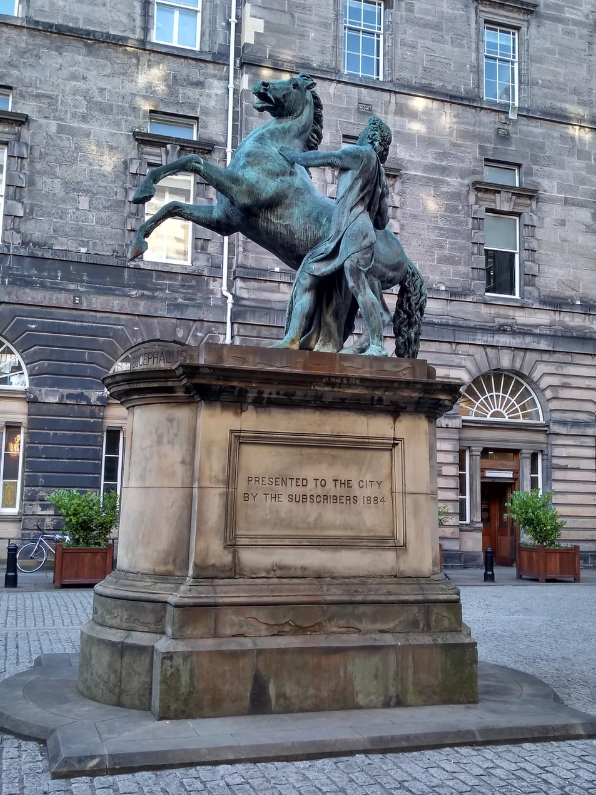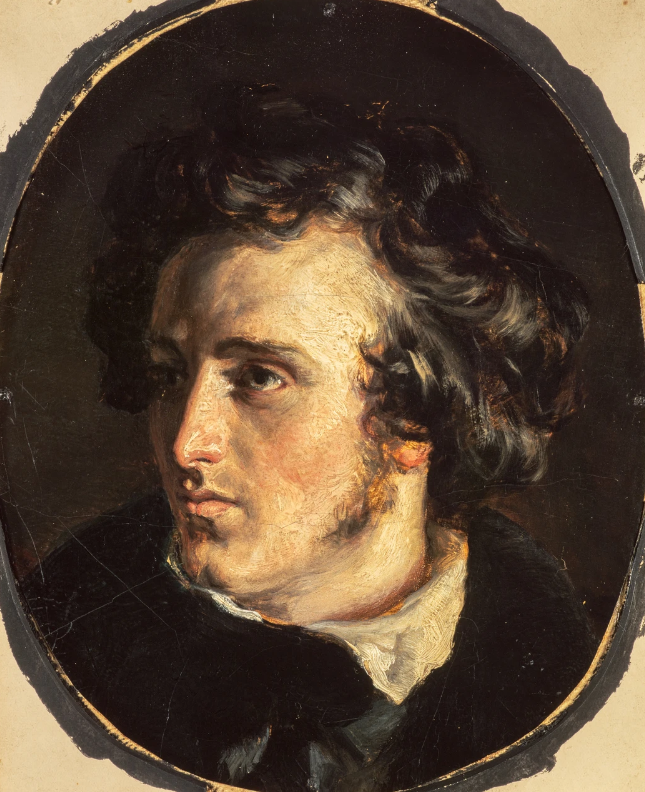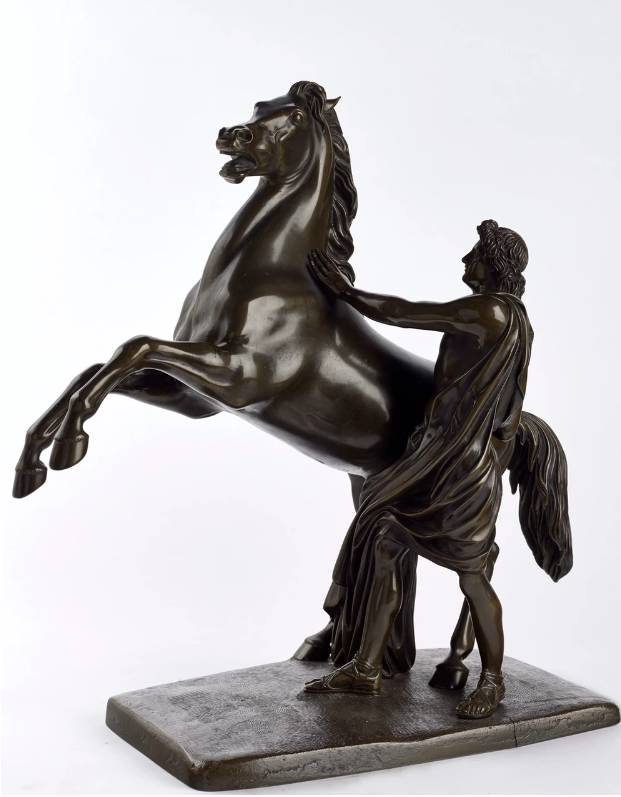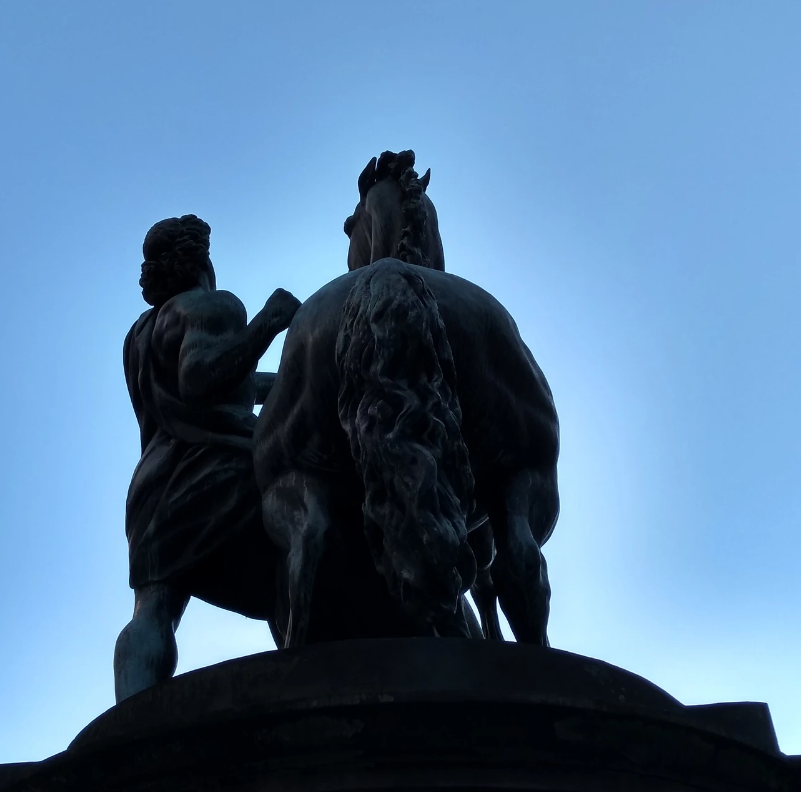Classics About Town: Alexander the Traffic Warden?
Alexander and Bucephalus outside Edinburgh City Chambers. (Author's photograph.)
The Royal Mile in Edinburgh is synonymous worldwide with many things – the Edinburgh Festival and Fringe, tourists and tourism, Scottish history, to name but the obvious ones. But one person you might be surprised to find there is Alexander the Great, that well-known Scottish… Hmm. Well, no, not really! The Macedonian king who conquered the known world just isn’t on that list. But he’s there.
In the heart of the Royal Mile, somehow largely obscured behind craft stalls, though just off the main thoroughfare of High Street by inches, stand Edinburgh City Chambers. In the quadrangle, in front of the building, stands a three metre high modern statue, on a substantial corniced ashlar plinth, of Alexander the Great and his horse Bucephalus. It’s a dramatic sculpture, embodying a young Alexander in the act of taming and preparing to mount Bucephalus, the wild horse that no one could mount but Alexander, for the first time. Thus, the statue is formally named Alexander and Bucephalus.
Exterior of City Chambers with view into quadrangle and Alexander statue inside. (Author's photograph.)
This episode is iconic in any telling of the history of Alexander (e.g. Plutarch Alexander 6), being linked to how the one who could tame Bucephalus was obviously destined for greatness. There are very few specific episodes related by his historians about Alexander’s youth, and this is always central to them (though the accounts differ slightly in content).
After Alexander’s death, when stories of his exploits expanded and, often, deviated from historical reality, the story of Alexander taming Bucephalus gained even more significance as a harbinger of Alexander’s destiny. In some versions of the so-called Alexander Romance (an ancient "novel" which was widely amended and reinterpreted by writers across the ancient world over a period of hundreds of years) the Delphic Oracle states that whoever can ride the man-eating Bucephalus through Pella (capital of Macedon) will rule the whole world (Stoneman 1991: I.17).
Alexander and Bucephalus formed an inseparable partnership until Bucephalus’ death, probably in 326 BCE during the Battle of the Hydaspes (geographically within modern Pakistan, though part of Alexander’s India campaign), e.g. Plutarch Alexander 61. However, again, accounts differ (a common malady where Alexander is concerned!). After Bucephalus's death, Alexander (hitherto with a major penchant for naming cities after himself) named a city after Bucephalus - Bucephala (though to be fair, Alexander also named a city after his dog).
In later iterations of the Alexander Romance, the deaths of Alexander and Bucephalus sometimes have major deviations to historical reality. In one version, the ever-loyal horse stands at Alexander’s deathbed, and Alexander’s last words are addressed to him. Bucephalus tears apart Alexander’s poisoner before dying himself with his master (Stoneman 1991: III.33). This gets an award for symmetry and poetic justice at the very least! Many amusing illustrations of Bucephalus at Alexander’s deathbed, alongside his other companions, exist and no one ever appears to bat an eye or consider this in any way remarkable.
Now, that is all very well, but what precisely are Alexander and Bucephalus doing popping up in Edinburgh? Why is he now acting as some semi-obscured traffic break outside the City Chambers (the quadrangle mainly gets used as a convenient carpark during opening hours)? Well, to be fair, he wasn’t originally positioned there…
As Edinburgh established herself as the ‘Athens of the North’ in the nineteenth century, with classical architecture abounding, other sculptural elements followed suit. For example, the intended Parthenon recreation, the Scottish National Monument, atop Carlton Hill was started in 1826 and never completed – which is a bit of a relevant theme and timeperiod as you’ll shortly see!
Alexander and Bucephalus is the work of the sculptor Sir John Steel (1804 – 1891). Steell is not a particularly well-known public name now, but a lot of his work still graces the centre of Edinburgh (e.g. the statue of Walter Scott at the Scott Monument). Steell was a famous and prolific sculptor in his day, appointed Sculptor in Ordinary for Scotland by Queen Victoria, and sculpted many notable Scots and establishment figures (including Victoria herself).
Robert Scott Lauder. Sir John Steell, 1804 – 1891. Sculptor. 1832. National Galleries of Scotland. Creative Commons CC-BY-NC. https://www.nationalgalleries.org/art-and- artists/3826?search=sir%20john%20steell&search_set_offset=41
Alexander and Bucephalus is an early work of Steell’s. It was commissioned by the city council in 1832 , moulded in 1832, and clay model exhibited at the Royal Institution in Edinburgh in 1833, and also in London. Steell was paid 100 guineas for the piece, about £20,000 today, plus a large sum in donations.
It has been suggested that the pose was inspired by Steell’s own trip to Rome in 1829. There are similarities between the sculpture and the frieze of the Scandinavian Bertel Thorvaldsen entitled Alexander the Great’s Entry into Babylon (currently on display in Copenhagen in Thorvaldsen's Museum). Thorvaldsen had a workshop in Rome when Steell visited at this time, and there do seem to be some resemblances to small portions of this frieze. How derivative the piece is is debatable, but it is possible that any heroic horse taming in a Classical style may well look fairly similar.
On commission, Steel also made an unknown number of miniature statuettes of the Alexander and Bucephalus sculpture in bronze, with grey marble plinths.
Alexander and Bucephalus. Edinburgh, after 1833. National Galleries of Scotland. Creative Commons CC-BY-NC. https://www.nationalgalleries.org/art-and- artists/78196?artists%5B5175%5D=5175&search_set_offset=6
The full-scale statue was not cast in bronze until 1883, around fifty years later, as Edinburgh council lacked the money to complete payment to Steell. It is said that Steell, in retaliation, remodelled Bucephalus’ ears into those of a pig (something comparison with the smaller statuettes seemed to substantiate). The full-size bronze statue was eventually cast at Steell’s own Grove Foundry in result of a subscription raised by the Duke of Buccleuch.
The statue was presented to the city by subscribers in 1884, being first erected in St Andrew Square in Edinburgh, before removal to its current location outside the City Chambers in 1916. Restoration work was carried out on the statue in 2014.
If you want to visit Alexander, and I would naturally suggest that you do, then I’d suggest early evening on a clear day. After the cars and bustle have gone, in the quiet before the sun’s gone down, that movement-filled rearing statue, against the surrounding building backdrop, and the changing colours of the sky, can be really lovely.
Alternatively, if you happen to be in Alexandria, Egypt, anytime soon, there’s a much more recently donated modern Alexander and Bucephalus statue there that you could go and compare. There’s also a one in Thessaloniki in Macedonia, but the Edinburgh variety is just as worthy of contemplation…
Back view of Bucephalus. (Author's photograph.)
Select further reading
Heckel, W. & Yardley, J. 2004, Alexander the Great: historical sources in translation, Blackwell Publishing, Oxford.
Stoneman, R. 1991, The Greek Alexander Romance, Penguin Books, London.
R. Stoneman, R. (ed) (2022) Alexander the Great: The Making of a Myth, The British Library, London.
About the author
Isabel Hood has two lives. One of these is her ancient life, in which she combines Egyptology and Classics. Currently she’s largely engulfed in reams of printout, writing a Masters dissertation on Alexander the Great in Egyptian Literary Tradition. She also edits the Egyptology Scotland society newsletter. In her other life, she works for the NHS in Scotland.






